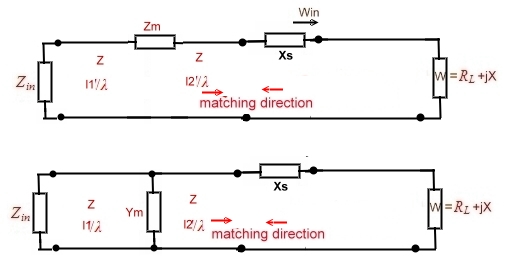
The horizontal (center) line of the chart represents pure The smaller circles correspond to higher, constant R Each circle represents a constant resistance (orĬonductance, G, = 1/R) value, as Figure 11-2 (b) shows: The largestĬircle, which outlines the chart, corresponds to a constant R value Point of tangency is called the common point, or infinity (4) Horizontal centerline of the chart, as Figure 11-2 (a) shows. Of Constant Resistance (R) Value The "R" coordinates of a SmithĬhart are a set of circles tangent at the right end of the To the characteristic impedance of the line, Z0. Impedance coordinates used to represent impedance at any pointĪlong a line in rectangular form: R jX: R is the purely resistiveĬomponent of the impedance jX is the reactive componentĪll resistance and reactance values on the chart are normalized Impedance are known, and vice versa the impedance of the load,įigure 11-1 shows a Smith Chart. Such as the SWR produced by a given load the reflectionĬoefficient, when the characteristic impedance and the load This chart simplifies evaluation of transmission line parameters, Graphical computation tool developed by Dr. Impedance MeasurementsThe Smith Chart The Smith Chart is a Magnitude of the reflection coefficient Phase angle of the Reflection coefficient at the load, expressed as a vector quantity

When ZL is not purely resistive, L is a vectorial quantityĬarrying both magnitude and phase information: L = where L = The impedance of a load, ZL is a complex quantity: it isĬomposed of a real, resistive part, R, and an imaginary, reactive L = Reflection coefficient at the load (dimensionless number,Ĭomprised between +1 and -1) ZL = Impedance of the load () Z0 = Instead, part of this energy is reflected back toward the source byĪ reflection coefficient L. Not all the energy incident at the load is absorbed by the load. Perfectly match the characteristic impedance of the waveguide, Z0, You have already learned, when the impedance of the load does not The Reflection Coefficient at the Load and the Load Impedance As You will be able to measure load impedances by using a
#Smith chart component calculator how to#
When you have completed this exercise, you will know how a SmithĬhart is constructed, and how to use it to determine load

When Z L is not purely resistive, Γ L is a vectorial quantity carrying both magnitude and phase information: Γ L = ρ where Γ L = Reflection coefficient at the load, expressed as a vector quantity ρ = Magnitude of the reflection coefficient φ = Phase angle of the reflection coefficient.Įxercise Impedance MeasurementsEXERCISE OBJECTIVES The impedance of a load, Z L is a complex quantity: it is composed of a real, resistive part, R, and an imaginary, reactive part ±jX. The relationship between Γ L and Z 0 is as follows: or where Γ L = Reflection coefficient at the load (dimensionless number, comprised between +1 and -1) Z L = Impedance of the load ( Ω ) Z 0 = Characteristic impedance of the line ( Ω ). Instead, part of this energy is reflected back toward the source by a reflection coefficient Γ L. DISCUSSION Relationship Between the Reflection Coefficient at the Load and the Load Impedance As you have already learned, when the impedance of the load does not perfectly match the characteristic impedance of the waveguide, Z 0, not all the energy incident at the load is absorbed by the load. You will be able to measure load impedances by using a slotted line and the Smith Chart. 11-1 Exercise 11 Impedance Measurements EXERCISE OBJECTIVES When you have completed this exercise, you will know how a Smith Chart is constructed, and how to use it to determine load impedances.


 0 kommentar(er)
0 kommentar(er)
